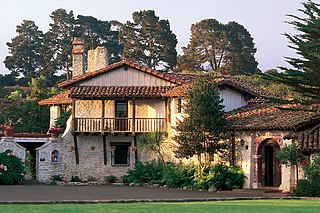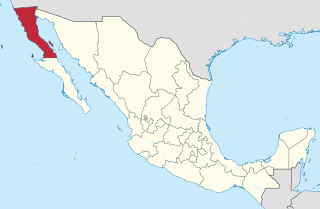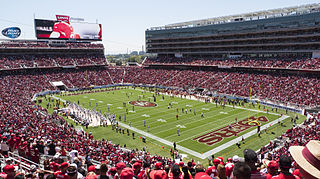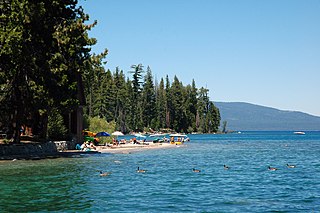
Los Angeles, officially the City of Los Angeles and often known by its initials L.A., is the most populous city in California and the second most populous city in the United States, after New York. With an estimated population of four million, Los Angeles is the cultural, financial, and commercial center of Southern California. Nicknamed the "City of Angels" partly because of its name's Spanish meaning, Los Angeles is known for its Mediterranean climate, ethnic diversity, Hollywood, and the entertainment industry, and sprawling metropolis.

Founded on June 3, 1770, Monterey was the capital of Alta California under both Spain and Mexico until 1850. Monterey hosted California's first theater, public building, public library, publicly funded school, printing press, and newspaper. Monterey was the only port of entry for taxable goods in California. In 1846, the U.S. flag was raised over the Customs House, and California became part of the United States after the Mexican–American War.

The 1984 Summer Olympics, officially known as the Games of the XXIII Olympiad, was an international multi-sport event that was held from July 28 to August 12, 1984, in Los Angeles, California, United States. This was the second time that Los Angeles had hosted the Games, the first being in 1932.

Northern California is the northern portion of the U.S. state of California. Spanning the state's northernmost 48 counties its main population centers include the San Francisco Bay Area, the Greater Sacramento area, and the Metropolitan Fresno area. Northern California also contains redwood forests, along with the Sierra Nevada, including Yosemite Valley and part of Lake Tahoe, Mount Shasta, and most of the Central Valley, one of the world's most productive agricultural regions.

The West Coast or Pacific Coast is the coastline along which the continental Western United States meets the North Pacific Ocean. As a region, this term most often refers to the coastal states of California, Oregon, Washington, and Alaska. More specifically, it refers to an area defined on the east by the Alaska Range, Cascade Range, Sierra Nevada, and Mojave Desert, and on the west by the Pacific Ocean. The United States Census groups the five states of California, Oregon, Washington, Alaska, and Hawaii together as the Pacific States division.

Baja California, officially the Free and Sovereign State of Baja California, is a state in Mexico. It is the northernmost and westernmost of the 32 Federal Entities of Mexico. Before becoming a state in 1952, the area was known as the North Territory of Baja California. It has an area of 70,113 km2 (27,071 sq mi), or 3.57% of the land mass of Mexico and comprises the northern half of the Baja California Peninsula, north of the 28th parallel, plus oceanic Guadalupe Island. The mainland portion of the state is bordered on the west by the Pacific Ocean, on the east by Sonora, the U.S. state of Arizona, and the Gulf of California, and on the south by Baja California Sur. Its northern limit is the U.S. state of California.

Mojave National Preserve is a United States National Preserve located in the Mojave Desert of San Bernardino County, California, USA, between Interstate 15 and Interstate 40. The preserve was established October 31, 1994 with the passage of the California Desert Protection Act by the US Congress. Previously, it was the East Mojave National Scenic Area, under the jurisdiction of the Bureau of Land Management. Mojave National Preserve is vast. At 1,600,000 acres (650,000 ha), it is the third largest unit of the National Park System in the contiguous United States.

A Mediterranean climate or dry summer climate is characterized by rainy winters and dry summers, with less than 40 mm of precipitation for at least three summer months. While the climate receives its name from the Mediterranean Basin, these are generally located on the western coasts of continents, between roughly 30 and 43 degrees north and south of the equator, typically between oceanic climates towards the poles, and semi-arid and arid climates towards the equator.

Cabo San Lucas, or simply Cabo, is a resort city at the southern tip of the Baja California Peninsula, in the Mexican state of Baja California Sur. As of 2015, the population of the city was 81,111 inhabitants. Cabo San Lucas together with San José del Cabo is known as Los Cabos. Together they form a metropolitan area of 305,983 inhabitants.

The Emerald Triangle is a region in Northern California, named as such due to it being the largest cannabis-producing region in the United States. The region is made up of Humboldt, Mendocino, and Trinity Counties. Growers have been cultivating cannabis plants in this region since the 1960s. The industry exploded in the region with the passage of California Proposition 215 which legalized use of cannabis for medicinal purposes in California. Growing cannabis in The Emerald Triangle is considered a way of life, and the locals believe that everyone living in this region is either directly or indirectly reliant on the marijuana business.

Bolsa Chica State Beach is a public ocean beach in Orange County, California, United States. It is located north of Huntington Beach and south of the community of Sunset Beach.

California's Colorado Desert is a part of the larger Sonoran Desert. It encompasses approximately 7 million acres (28,000 km2), including the heavily irrigated Coachella and Imperial valleys. It is home to many unique flora and fauna.

Lake Perris is an artificial lake completed in 1973. It is the southern terminus of the California State Water Project, situated in a mountain-rimmed valley between Moreno Valley and Perris, in what is now the Lake Perris State Recreation Area. The park offers a variety of recreational activities. Because of this and the lake's proximity to major population centers, it is very crowded during the summer months.

The climate of California varies widely, from hot desert to polar, depending on latitude, elevation, and proximity to the coast. California's coastal regions, the Sierra Nevada foothills, and much of the Central Valley have a Mediterranean climate, with warmer, drier weather in summer and cooler, wetter weather in winter. The influence of the ocean generally moderates temperature extremes, creating warmer winters and substantially cooler summers in coastal areas.

California currently has 19 major professional sports franchises, far more than any other US state. The San Francisco Bay Area has seven major league teams spread amongst three cities: San Francisco, Oakland and San Jose. The Greater Los Angeles Area has ten major league teams. San Diego and Sacramento each have one major league team.

The 2028 Summer Olympics, officially known as the Games of the XXXIV Olympiad, and commonly known as LA 2028, is a forthcoming international multi-sport event that is scheduled to take place from July 21 to August 6, 2028, in Los Angeles, California, United States.

Caswell Memorial State Park is a state park of California, United States, preserving a riparian forest along the Stanislaus River. It is located in southern San Joaquin County southwest of the town of Ripon. Riparian Oak Woodland, located in this park, is threatened and the park is trying to protect it. It once flourished through California's Central Valley. Caswell is also the home to several endangered species. The 258-acre (104 ha) park was established in 1952.

Ed Z'berg Sugar Pine Point State Park is a state park in California in the United States. It occupies nearly two miles of the western shore of Lake Tahoe and a total of about 1,000 hectares of forested mountains in El Dorado County. Originally called Sugar Pine Point State Park, its name was changed in 2003 to honor Edwin L. Z'berg, a California state assemblyman who specialized in environmental legislation and worked to develop state parks and other natural areas.





















